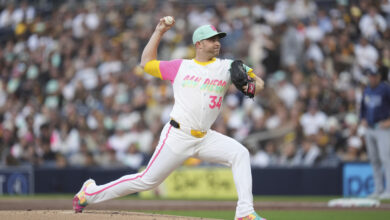
Cubs Need to Address Closer Situation Immediately if Not Sooner
There are myriad situations in which three weeks of baseball gives us far too little information for pronouncements, but the Cubs’ closer role is not one of them. While Michael Fulmer has struck out 11 batters in just 8.1 innings of work, he’s blown two games against the Dodgers in less than a week and his other outings haven’t all been smooth. His .455 BABIP against suggests bad luck has hurt him and his 7.56 ERA is highly inflated by the latest of those, a grand slam by James Outman that cost the Cubs Thursday’s contest, but this isn’t just about small-sample shenanigans.
The bigger issue is that Fulmer’s cutter, the pitch he throws more than all his other offerings combined, just isn’t working consistently as a put-away pitch. He’s always gotten more sweep than depth, generating above-average horizontal movement with below-average vertical, it’s just that he’s not locating the ball out of the zone often enough. Even worse, he’s putting it right in hitters’ happy spots all too frequently.

Of the eight cutters he threw in 23 total pitches — about 20% fewer than his average — only three missed the zone. One of those was ball three to Jason Heyward, a groundball machine from whom a clockwork chunker to the right side would have ended the inning. Instead, the former Cub fouled off four changeups and spat on several other pitches that missed badly, including a sinker on the ninth pitch of the plate appearance that might have hit a right-handed batter in the calf.
Outman had already homered earlier in the game and he’d watched his teammates face several cutters that easily qualified as dickballs if we’re getting into some of the game’s nomenclature. David Peralta‘s leadoff single came against an inside fastball, but he took a cutter that hung middle-up. Miguel Vargas then jumped on a cutter that caught way too much of the outer third and singled to right.
If that sounds familiar, it’s because those two batters led to Fulmer’s demise last Saturday in LA. Vargas saw four cutters in his at-bat, the last of which again stayed over the plate — though at least it nipped the border of the zone with its outer edge — enough for him to double and put two men in scoring position. After Heyward struck out on a changeup in the dirt that almost certainly influenced Fulmer’s approach Thursday night, Peralta whacked a first-pitch cutter that hung middle-down in the reddest portion of his heat map for a walk-off single.
The pitch Outman drove out of the ballpark for the game-winning slam was in nearly the same location as the one Peralta hit, which may have been the problem. Fulmer’s changeup and cutter are thrown with pretty much identical velocity, but the former ends up down below the zone more often than not. Outman had just taken a change in the dirt to run the count full and he may well have been sitting on another after seeing how Heyward was attacked.
So when Fulmer missed with the cutter, which was lower than usual and sure as hell didn’t bust the lefty batter inside as intended, Outman punished the mistake. That hit pushed lefties’ slash line to .438/.500/.875 against Fulmer so far this season, an unsustainably high level that nonetheless offers more than a little cause for concern. The Dodgers sent three lefties to the plate against Fulmer in the 9th and the results were as follows: Single, walk, grand slam.
The Cubs were short-handed and had to lean on the bullpen more than they’d have liked with Javier Assad filling in for the injured Jameson Taillon, but the lefty-heavy LA lineup just isn’t a good matchup for Fulmer. Lefty Brandon Hughes had already pitched in the game, but Mark Leiter Jr. hadn’t thrown since Tuesday in Oakland after dominating the Dodgers twice in LA with his wicked splitter. One or the other of them should get at least one more shot over the weekend, preferably in high-leverage situations.
Fulmer still has plenty of time to round back into form over the course of the season, but it would be wise in the meantime for David Ross to explore other options in the 9th. One of those could be Jeremiah Estrada, who has pitched six scoreless innings with seven strikeouts, two hits, and two walks for the Iowa Cubs. His stuff looked good when he came up last season and he was a dark horse candidate during spring training to break camp as the stopper.
The Cubs have several other in-house options as well, headlined by Adbert Alzolay and Keegan Thompson. Both have worked multiple innings several times already and could still be called upon to get more than four outs on a regular basis, so the only real transition would be when they’re entering the game.
Another possibility is to go with a committee and just give save situations to whoever is available and presents the best matchup for that given game. While my personal preference is to have more of a set role in order to allow the closer to adequately prepare both mentally and physically, it might be in the team’s best interest to see who really rises to the occasion. Maybe that ends up being Fulmer at some point, it just shouldn’t be him right now.
If the Cubs really want to compete, and it certainly appears that’s the case, they’ve got to figure this closer business out quickly.

